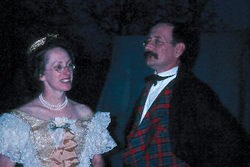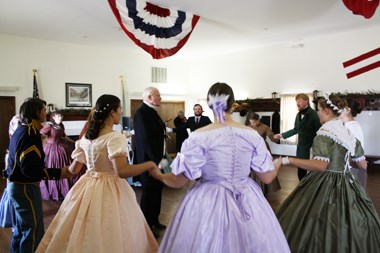
Dancing was a popular form of entertainment among both the officers and the enlisted men. At Fort Shaw, Montana in 1878, the commander and his wife enjoyed a dinner or card parties almost every day as guests. Several luncheons and suppers were, "quite elegant, formal affairs, beautifully served with dainty china and handsome silver." This delightful series of parties celebrated the end of summer campaigns and included not only feasting but dancing as well. Actually, the combination of food and tripping the light fantastic proved almost standard procedure. "Hops," as the old army referred to these gatherings, demonstrated as much ingenuity as the preparation of meals. Alice Baldwin, an officer's wife, mentioned that after one wedding, a ball given in honor of the bride and groom "was unique and original, considering much that was necessary to beautify and adom," could not be found for hundreds of miles. Four of the local ladies converted a half completed stone building by using tent-flies and canvas for the roof and floors and hung army blankets in the paneless windows. Although the whole place was draughty, "two large box stoves, piled full of wood by the soldiers, together with the activities of dancing, kept everyone warm enough to be comfortable." 
Rebecca Anderson, FOSC VIP Numerous other more elaborate examples of guidon draped barracks illuminated with candles and enlivened by bright brass buttons on dark blue dress coats fill narratives of the period. Suffice it to say, these dances ran the gamut from the elegant to very basic, just as dinners did. Unlike culinary efforts, however, which chiefly involved the officer class (save on special holidays) the entire garrison could participate in a hop. This fact prompted one dragoon sergeant of the 1850s to contend that, "even the roughest seemed to rise a little higher and to think better of themselves," when they attended a formal ball opened to all personnel. Less extravagant affairs sometimes produced a very different response as noted by an officer of the 10th Infantry in 1858. Some of the privates of the regiment put on a dance which turned into a drinking spree. Fighting broke out and the provost marshal had to intervene, but not before several of the men were injured. Probably few, if any, women were present at this function, since attendance by the fairer sex usually insured a higher standard of conduct. Even when ladies were in short supply, the men took things in stride. Sometimes they had to dance with male partners which one officer at a remote pre Civil War post admitted was, "rather dull," but claimed it was better than being a wallflower. Improvisation likewise extended to the musical accompaniment for dances. On many occasions, a guitar, banjo, fiddle or some other locally available instruments had to be pressed into service as an impromptu orchestra. On the other hand, most larger garrisons boasted regimental bands. While these organizations regularly fell victim to government neglect and parsimony, several enterprising commanders went to great lengths to recruit, train and equip groups of martial music makers. One of the more popular dance steps of the time was the Virginia Reel .
|
Last updated: May 25, 2022

